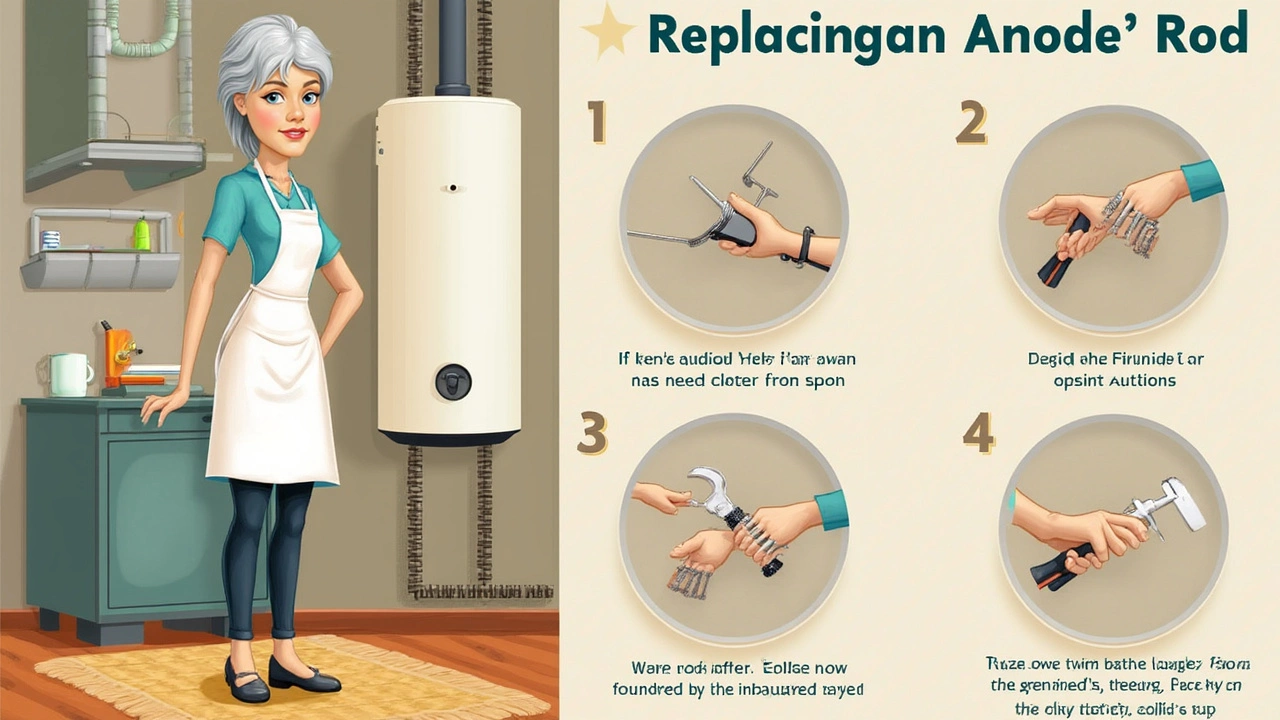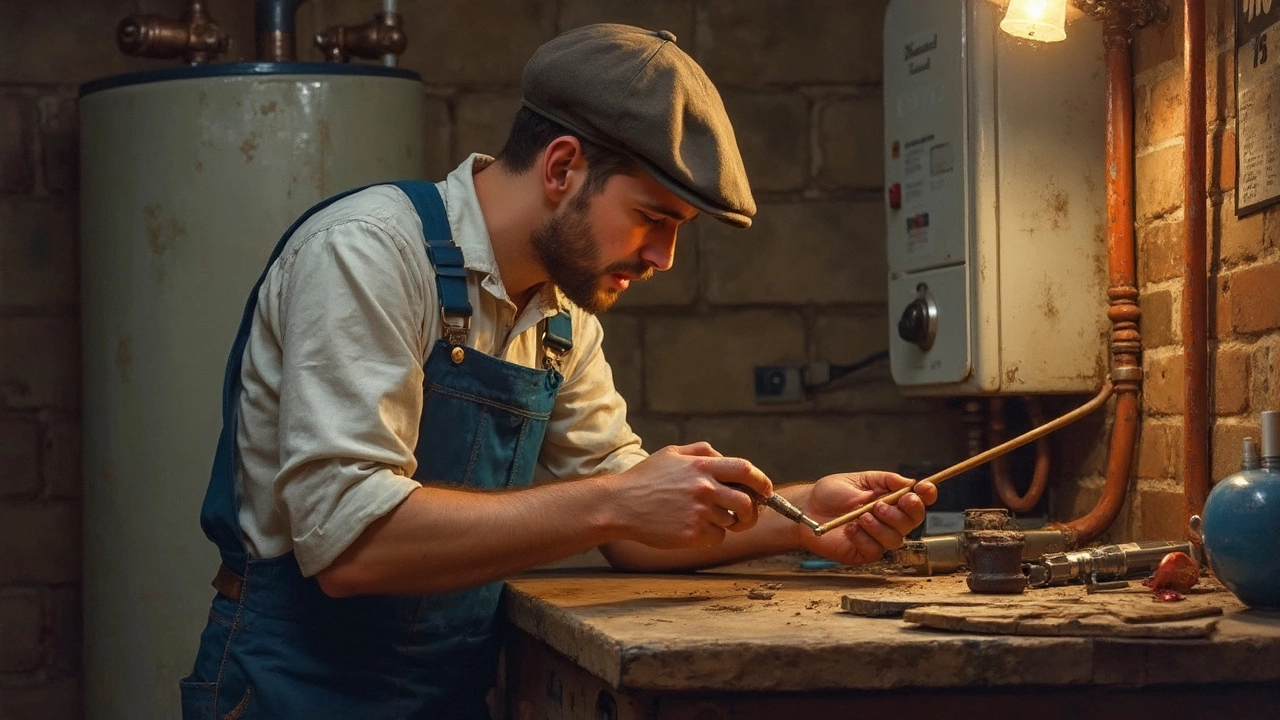If your water heater is acting up, a bad anode rod might be the culprit. But what's an anode rod anyway? Picture this: it's a metal stick inside your water tank that's designed to sacrifice itself to protect the tank. Sounds heroic, right? This rod attracts all the gunk and corrosion, so your tank stays in good shape.
Now, why care about it? When your anode rod goes bad, your tank starts to rust. And trust me, rust is the least of your worries. It can cause leaks, reduce the efficiency, and generally make a headache out of something you hoped to never think about.
But before you panic, let's go through some telltale signs your anode rod needs help. Finding white buildup around the tank? Hearing weird noises? Or maybe your hot water smells off? These are just whispers that the rod's crying out for attention.
- Understanding the Anode Rod
- Signs Your Anode Rod Is Failing
- How to Check the Anode Rod
- Replacing a Bad Anode Rod
- Tips for Maintaining Your Water Heater
Understanding the Anode Rod
The anode rod might sound like something out of a sci-fi movie, but it's really just a simple metal stick made from magnesium, aluminum, or zinc. Its main job? To protect your water heater tank from corrosion. Think of it as the bodyguard standing between your tank and nasty rust.
Here's how it works: The anode rod hangs out inside your water heater tank. It's more reactive to corrosive elements than the steel tank itself. So, these elements go after the anode rod, corroding it instead of the tank. That's why it's sometimes called a “sacrificial rod.” Pretty cool for something so simple, right?
Types of Anode Rods
- Magnesium Rods: Often the top choice for homes with soft water, they offer excellent protection but may not last as long in very aggressive water conditions.
- Aluminum Rods: A more budget-friendly option, aluminum rods last longer but could create sediment in the tank, which might be problematic over time.
- Zinc Rods: These are basically aluminum rods with a little zinc added to fight off that annoying rotten egg smell some homes experience with hot water.
Why Is the Anode Rod Important?
Here's a fun fact: If regularly checked and replaced when needed, your anode rod can effectively double the lifespan of your water heater! Without it, you might be looking at replacing the whole unit much sooner than you'd like. Just think about the cost of a new water heater compared to a simple anode rod replacement.
Checking the Condition
Wondering how long an anode rod lasts? Generally, you want to give it a peek around every three to five years. But this can depend on water quality. Hard water? Maybe check sooner. Spotting one that's looking pretty eaten up signals it's time for a swap. Keeping a close eye ensures your tank avoids unexpected breakdowns.
Signs Your Anode Rod Is Failing
Wondering if your anode rod is waving a white flag? Look out for these signs before your water heater gives up the ghost:
1. Odd Smells or Tastes
If your hot water suddenly smells like rotten eggs, it could be a clear shout that the anode rod has gone bad. This is usually due to sulfur bacteria reacting with the metal.
2. Murky or Discolored Water
Finding rusty or cloudy water coming from the tap? It indicates that your anode rod is struggling, allowing the tank to corrode.
3. Strange Noises
Your water heater sounding more like a drum set than a household appliance? Banging, popping, or crackling noises can mean mineral deposits have formed, a sign that the rod is no longer effective.
4. Visible Corrosion or Buildup
Spotting white crusty buildup around your heater's connections? This is often caused by a failing rod. It's like your heater is screaming it needs attention.
5. Reduced Heating Efficiency
If it seems like your water isn't as hot or you run out quicker than usual, this might be the rod letting you down. Keep an eye on these signs to prevent bigger headaches down the line!
Periodic check-ups are your best bet. Most experts suggest looking at your anode rod every 6 to 12 months and replacing it every 3 to 5 years. Constant maintenance will keep your tank running smoothly and extend its life significantly.

How to Check the Anode Rod
If you’re ready to check your water heater's anode rod, grab some basic tools and let’s get started. It’s not rocket science, but it’s important to do right. You’ll need a wrench, some Teflon tape, and maybe a friend to help out—it's easier with an extra pair of hands.
Step 1: Turn Off the Power and Water
First off, the power. Shut off the electric supply or turn the gas valve to pilot mode—safety first! Next, turn off the cold-water supply to the heater. Trust me, you don’t want water gushing everywhere.
Step 2: Locate the Anode Rod
The anode rod is usually on top of the water heater, looking like a hexagonal plug. Sometimes, it might be beneath a cap. If your heater’s in a tight spot, things might get tricky, but hang in there!
Step 3: Drain Some Water
You don’t need to drain the whole tank. Just attach a hose to the drain valve and let out a few gallons. It makes taking the rod out way easier without burning yourself or making a mess.
Step 4: Remove the Anode Rod
Use your wrench to loosen and slowly remove the rod. Watch out—it might be corroded, and you don’t want debris falling everywhere. If it looks more like a beat-up relic and less like a rod, it’s time for a new one.
Step 5: Inspect and Decide
A quick glance will tell you if the rod’s too far gone—it should be replaced if less than half inch thick. Here’s a tip: once you see considerable corrosion, don’t wait. Replace it before the tank gets damaged.
| Condition | Action |
|---|---|
| Metal exposed | Replace immediately |
| Slight corrosion | Monitor regularly |
| Intact | Check back in a year |
And that’s it! Checking the anode rod isn’t tough, but it’s a key part of water heater maintenance that’ll save you heaps in the long run. Remember, a healthy rod means a happy tank.
Replacing a Bad Anode Rod
So, your anode rod is toast. No worries, replacing it is easier than you think. Grab your tools, and let’s keep that water heater running smooth.
Gathering Your Tools
First things first, gather a few basic tools. You’ll need a wrench, some Teflon tape, and the right replacement anode rod (made of magnesium or aluminum, depending on your water type). Your local hardware store should have what you need.
Steps to Replace the Anode Rod
- Turn Off the Power and Water: Safety first! Flip the circuit breaker, or set the gas valve to 'pilot.' Then, shut off the water supply to the heater.
- Drain a Bit of Water: Attach a hose to the tank's drain valve. Drain a few gallons so the rod swap won’t turn into a splash zone. Re-close the valve once done.
- Locate and Remove the Old Rod: Anode rods are usually on top. Use your wrench to loosen it. It might be stubborn, but a little elbow grease will do the trick.
- Install the New Anode Rod: Wrap some Teflon tape around the threads of your new anode rod to ensure a good seal. Tighten it in place with your wrench.
- Refill and Restart: Turn your water supply back on. Once the tank is full, power the heater back up. Listen for anything weird, which could mean an incorrect installation.
Consider a Flexible Anode Rod
If your water heater is in a tight spot, consider installing a flexible anode rod. They can bend, making installation in cramped spaces a breeze.
Check the Benefits
| Type | Durability | Best For |
|---|---|---|
| Magnesium | High | Soft Water |
| Aluminum | Moderate | Hard Water |
| Flexible | Varies | Compact Spaces |
Keeping an eye on your anode rod isn’t just maintenance—it’s setting yourself up for years of washing, showering, and dish-cleaning bliss. Swap that rod before it's too late!

Tips for Maintaining Your Water Heater
Keeping your water heater in top shape doesn't have to be rocket science. Just a few simple steps can make a huge difference in extending its lifespan and maintaining its efficiency.
Regular Inspections
Get into the habit of checking your water heater regularly. Look for any leaks, rust spots, or puddles beneath the tank. These could signal a failing component like a anode rod or something else that needs your attention.
Flush the Tank Annually
Once a year, drain and flush your tank. This helps remove sediment buildup, which can reduce efficiency and even damage the tank. It's really not as daunting as it sounds. Just attach a hose to the drain valve, run it to a safe area, and let the water flow until it runs clear.
Check the Anode Rod
Your anode rod is a key player in the battle against rust. Check it every couple of years, and replace it when it's less than half an inch thick or covered in calcium. Your water heater will thank you!
Monitor the Temperature
Keeping the temperature set around 120 degrees Fahrenheit not only prevents scalding but also reduces energy use. Plus, it helps extend the life of your water heater because hotter temperatures can cause excess wear and tear.
Install an Expansion Tank
If your home has a closed plumbing system, consider installing an expansion tank. It absorbs extra water pressure, easing stress on the water heater and extending its life.
Keep the Area Clear
Make sure there's at least a foot of clearance around your water heater. This ensures good airflow and helps avoid buildup of flammable materials, keeping things safe and functioning well.
Following these straightforward steps can keep your water heater running smoothly for years. With a little attention, you can avoid the daunting task of unexpected repairs and keep those hot showers coming without a hitch.

I am an expert in the services industry with a focus on appliance repair. My passion lies in understanding how things work and educating others in simple, engaging ways. This enthusiasm fuels my writing, where I delve into topics around appliance maintenance and troubleshooting. I aim to make these subjects clear and accessible to all readers.